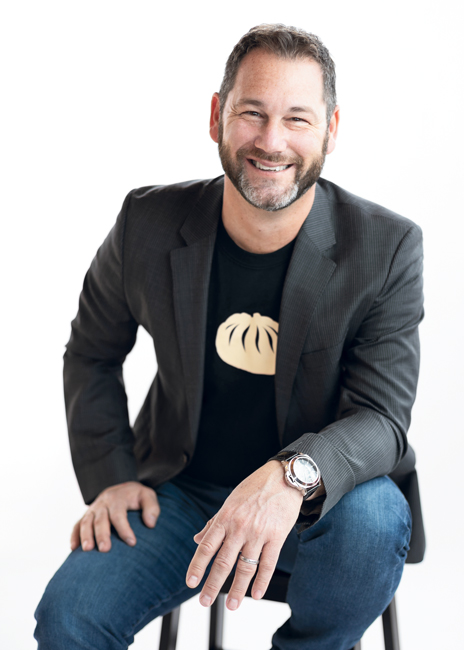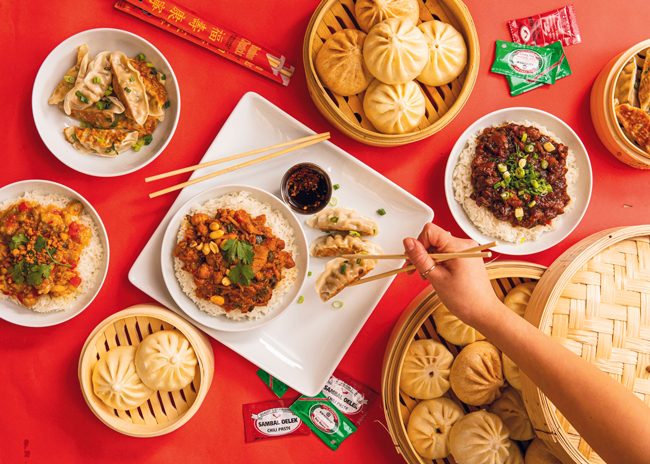Wow Bao, an Asian fast-casual brand created in 2003 by Chicago-based Lettuce Entertain You Enterprises, has, over nearly two decades, done things differently.
Aside from introducing an unfamiliar street food — its signature steamed Chinese buns — to mainstream U.S. consumers, Wow Bao was an early adopter of technology and omni-channel strategies. Under the leadership of Geoff Alexander, who took the reins in 2009, the brand implemented mobile and desktop ordering, delivery, self-serve kiosks and fully automated storefronts with high-tech pickup cubbies. Alexander’s team pioneered an app-based gift card and loyalty program, added nationwide third-party shipping, began licensing the brand nationally in nontraditional segments and selling Wow Bao products in grocery stores.
In 2017, the year Valor Equity Partners took a majority stake in the brand, Alexander led Wow Bao into the delivery-focused ghost kitchen arena. That experience, followed by a pandemic that overnight fueled a need for much of what Wow Bao was already doing, set the company on a new course. It’s a course centered on the win-win magic of dark kitchens and, more recently, bringing a game-changing new virtual brand to market.
 Geoff Alexander, President and CEO, Wow Bao, Managing Partner, Lettuce Entertain You Enterprises, ChicagoQ: How did Wow Bao’s early entry into ghost kitchens lead to the dark kitchen model now fueling its growth?
Geoff Alexander, President and CEO, Wow Bao, Managing Partner, Lettuce Entertain You Enterprises, ChicagoQ: How did Wow Bao’s early entry into ghost kitchens lead to the dark kitchen model now fueling its growth?
A: We were already playing in virtual in 2017, operating at a CloudKitchens facility in Los Angeles. We turned that off in 2018 after testing and learning from it. That experience gave us great insight into this model. A year later, we were talking about how we could grow the concept and what’s next for the brand. We looked at the combined restaurant networks of Valor Equity and Lettuce Entertain You and got this idea: Why couldn’t other restaurants sell our food for third-party delivery? We already had national distribution in nontraditional segments. This could be a way to expand our footprint while helping other operators grow top-line sales and profitability. We launched the dark kitchen initiative in January 2020 with one restaurant in Chicago and started talking to more. Then COVID-19 hit. Since April 2020, we’ve opened more than 600 dark kitchen locations across 41 states. We plan to get to 1,000 by the end of this year.
Q: Are traditional third-party ghost kitchens still in the mix?
A: Yes, but in a different way in that we’re not the ones operating them. We have agreements with Ghost Kitchen Brands and REEF Kitchens. Even Kitchen United, which normally just leases space, is operating our brand. Our model is so easy that any of them can take it and scale it.
Q: The ability to scale easily is what presumably makes your dark kitchen model so attractive. How does it work?
A: We license our brand to be prepared by other operators and made available via third-party delivery apps. We coordinate with delivery providers and handle initial marketing, social media and training. We pared our regular restaurant menu down to the top 30%. It’s about 11 SKUs that the dark kitchens are buying to produce 18 or 20 menu items, including combos. Everything comes in frozen, via broadline distributor, with a nine-month shelf life and a three-day thawed shelf life. All they need is a steamer, a flattop and a rice cooker. Most places already have a flattop. If they don’t have a steamer, we have a $60 kettle that works over a burner. So for a small startup fee and less than $300 in equipment, they’re in. We do a 3-month contract that auto-renews for 12 months. But if it doesn’t work for the operator, they just stop buying our product and turn off the apps.
Q: It seems a great way for Wow Bao to expand its footprint, but what’s the payoff like for the operators?
A: Our goal is for every operator to do at least $2,000 a week, or about $100,000 a year. We created a cost model that’s 35% food and packaging combined, inclusive of 15% broadliner markup. After 25% average commission from the delivery providers, that nets a 40% return because there’s virtually no overhead or additional labor. So on $100,000, or $2,000 a week, they can make about $40,000. We have operators who are doing $6,000, $8,000, $9,000 a week, and we have some who have 10, 20, 50 locations with us.
 For dark kitchens, Wow Bao’s menu was pared down to the top 30% of items. Operators purchase 11 SKUs to produce 18 to 20 menu items, including combos, for delivery.
For dark kitchens, Wow Bao’s menu was pared down to the top 30% of items. Operators purchase 11 SKUs to produce 18 to 20 menu items, including combos, for delivery.
Q: In what ways did the pandemic impact your ability to run with the dark kitchen model?
A: First, there was the reality of everyone simply needing sales to survive. It was a way we could help. Second, we all learned that we have excess capacity, and we started thinking differently. Typically, 80% of sales comes from 20% of the menu. If we have 50 items, 35 of those aren’t contributing much. Why not lose a handful of slow movers and turn on an additional brand that’s easy to execute for delivery? We used to all be like, ‘This is my business. This is how I do things. I’m not sharing my recipes or secrets.’ One of the greatest things to come out of the pandemic, and a reason why this has been successful for so many, is that we began to embrace collaboration.
Q: Collaboration also led to your launch of a new virtual brand, Crazy Crispy Chick’n. How did that come about?
A: Valor, our private equity partner, met with the team behind Skinny Butcher, a new plant-based chicken brand that was looking for funding. Valor called us and said, “You guys need to taste this.” They felt we could do something with it like we’re doing with Wow Bao. We really liked the product. The flavor, texture and mouthfeel are exactly like chicken. We also liked the fact that it’s not soy-based, which is a differentiator, and the variety. They don’t just have nuggets, but also tenders and breasts. With our help, they now have sliders, too, and they took our input on things like color and breading.
Q: So it’s now another option for your dark and ghost kitchens alike?
A: Right. We started it from three Wow Bao restaurant kitchens in Chicago and have inked a deal with REEF Kitchens. We’re reaching out to our early adopters and strong Wow Bao dark kitchen operators, positioning it as an opportunity to add another revenue stream. All they need is a fryer. If they’re already doing burgers, they have all of the mise en place. We hope to see triple-digit growth this year and exponential growth in 2023.



